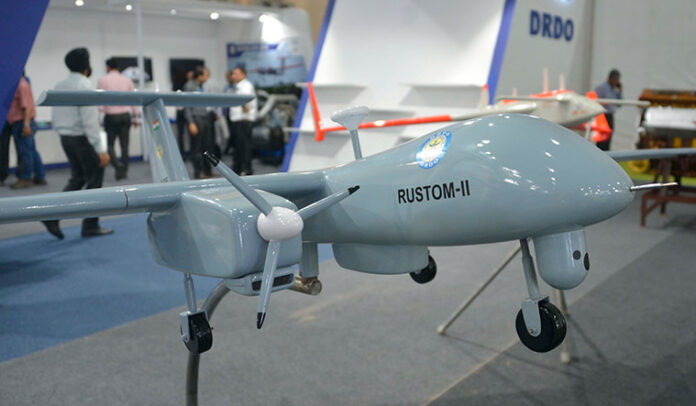Recently in June, a defence delegation from the Republic of Armenia visited India, meeting with their counterparts here. The delegation came armed with a shopping list. While little is known about its contents, drones have been confirmed to have figured prominently on the list. But not drones alone, an official confirmed without going into any further details. This is not the first time that Armenia has evinced interest in Indian military hardware. In 2020, it concluded a deal with India worth 40 million for the supply of four indigenously built weapon-locating radars. The SWATHI radars have been developed by the Defence Research and Development Organisation (DRDO).
Since then, Armenia’s defence requirement has grown exponentially. ‘The Karabakh war made us rethink our defence needs,’ said an Armenian official who did not want to be named. The war referred to the one the tiny South Caucasian nation fought with Azerbaijan over the contested territory of Nagorno-Karabakh. For twenty years the Armenians had held the ethnic Armenian enclave which technically formed part of Azerbaijan, as a result of the controversial borders drawn up during the erstwhile Soviet Union where the exercise was primarily based on keeping individual republics dependent on Moscow.
However, in 2020 Armenia lost all the territory to Azerbaijan, including the corridor that connected Armenia to the enclave. Though a member of the Russia-led Collective Security Treaties Organisation (CSTO), Russia refused to intervene in the war since it considered Nagorno-Karabakh to technically not be ‘Armenian territory’. Russian defence equipment also proved not to be a match for the Turkish equipment that was deployed, especially Turkish Bayraktar TB2 drones. Turkish military counsellors and arms won the war for Azerbaijan. ‘Russia intervened only when it felt Turkey would become a permanent presence in the region,’ said the official bitterly. The result – a Russian peace keeping force in Nagorno-Karabakh. But the war also showed the limits of Western support and help for Armenia, as well as the limits of Armenian soft power -primarily its diaspora abroad, which is a source of pride for many Armenians. Armenia, even as located in a hostile neighbourhood, remains dependent on Russia. And Russia now remains focused on Ukraine.
The war has also isolated Armenia in other ways, by way of few foreign investments, decline in trade and commerce, exacerbated by the pandemic. Cash strapped Armenia has been unable to modernise its industrial base or step up its R and D. Armenian analysts bemoan the fact that the country has been unable to take advantage of China’s Belt and Road Initiative and coveted Chinese investments seemed to have bypassed the tiny country even as rivals Azerbaijan and Turkey have apparently benefitted. It is another matter that along with investments Armenia has also escaped the famous Chinese debt trap unlike similarly cash strapped Tajikistan, for instance. But its bilateral trade with China amounting to $873 USD is heavily tilted in favour of the latter. It would also be interesting to know how Armenian analysts view events in Sri Lanka.
This makes the situation very favourable for India. India’s ties with Armenia are civilizational, thanks to its diaspora, Armenia and India continue to share a unique bond. High profile visits have characterized bilateral relations, and new life was breathed into the relationship beginning with Prime Minister Narendra Modi’s meeting with Armenian President Nikol Pashashian in New York in September on the sidelines of the UN General Assembly. India sees Armenia not only as a friend but a good counterweight to Turkey whose President Recep Tayyip Erdogan has been particularly belligerent on the Kashmir issue, and followed a number of policies inimical to India, as well as to Azerbaijan, closely allied with Turkey and Pakistan.
Armenia is strategically located bordering Russia, Iran, Turkey. It is a significant part of multimodal trade routes. The Armenian North South Road Corridor is being developed to connect the Black Sea ports through the territory of Armenia and Georgia and further to Europe.
The implementation of the Project is expected to improve Europe – Caucasus – Asia road communication at the intersection of West Asia and East Europe. During his visit to Yerevan last year in October, External Affairs Minister S. Jaishankar pledged his support for the corridor. Earlier in 2021, Armenia was included in the virtual conference to commemorate the Chabahar Port. Its North South Corridor easily connects to the International North South Transport Corridor that India is involved in together with Russia and Iran. The first freight recently arrived through the INSTC from Russia to India. The Armenian Road Corridor becomes a natural part of the INSTC, which India has pitched for further linking to the Chabahar Port which it is helping develop.
Together with defence, trade, and investments, Armenia can become a strategically significant partner for India, where India can set up bases and a commercial and defence hub for joint manufacture and Indian exports beyond. Located in Russia’s sphere of influence, this is an additional advantage for India. Any Indian bases there should not be irksome to Russia, even as it offers an alternative to Armenia and will preempt China’s expanding footprint.














